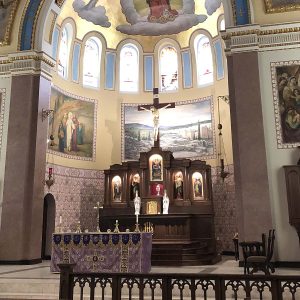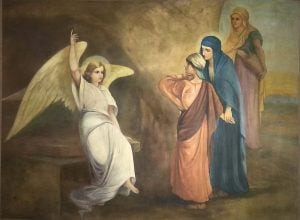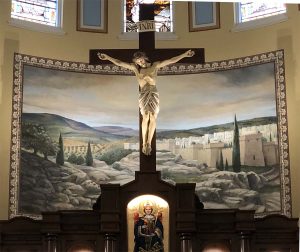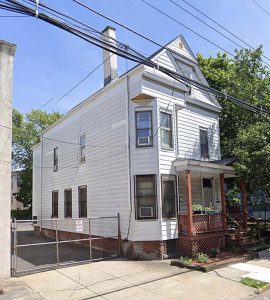By Stephen Enzweiler
Special to the NKyTribune
(This is the fourth part of a five-part series on the history of St. Augustine Parish, Covington.)
The construction trucks are gone. The piles of material no longer darken the parking lot. The sharp pounding and whirrs of hammers and drills that once echoed inside St. Augustine Church during its recent renovation are also silent. Inside, the scaffolding has come down and the construction crews are no more. In their wake, they have left the people of Peaselburg and Covington a restored masterpiece of Italian Renaissance architecture, dazzling in its reborn beauty and sweeping in its ability to inspire. Enter its doors and one is quickly carried away into another world of lofty spaces beneath broad arches and blue, star-bemused ceilings.

St. Augustine’s sanctuary with its historic apse murals. (Photo by Stephen Enzweiler)
St. Augustine was designed by architect David Davis, whom Bishop Maes had previously hired to design St. Patrick’s Church in Maysville and the Cathedral Basilica’s façade in Covington. “The church has been declared by many to be the most beautiful in the diocese,” reported the Catholic Telegraph after its [St. Augustine’s] dedication in 1914, “and was highly praised by the Rt. Rev. Bishop (Maes) for the devotional atmosphere supplied by the simple beauty.”
Like most churches constructed during the episcopate of Bishop Maes (1885–1915), art and architecture and the spiritual value they contained for the faithful, were of the highest importance. When Davis presented the St. Augustine plans to him in 1913, the bishop was eager to approve the Italian approach, a style with which he was familiar from his own study of architecture as a young man, and which he enjoyed sumptuously in his later years on trips to Rome after he became a bishop. It was a style he especially appreciated, not just for its symmetry, proportions and classical elements, but also for its sense of air and light, which gives this style of architecture the mystical ability of drawing one into the experience of heaven on earth.

“The Lord’s Tomb on Easter Sunday,” believed to be the work of William Blank. (Photo by Stephen Enzweiler)
Among the inspiring art decorations we see today in St. Augustine are the beautifully sculpted Stations of the Cross, crafted in Italy and imported in 1914. Throughout the church, there is traditional statuary made by the renowned Daprato Rigali Studios, a company founded in 1860 in Italy by four brothers who immigrated to the United States from the Tuscan town of Barga, hoping to bring the Italian craft of statue-making to the United States. Then there are the ethereal murals that decorate the apse, dome, sanctuary and transepts, each executed in the neo-classical style then in vogue during the height of Catholic church construction in the 19th and 20th centuries.
But unlike known works of art in St. Augustine, the identities of who painted its beautiful and much-admired murals has always been a mystery to art historians. It was not an uncommon practice for churches of earlier times to record the cost of works of art while simultaneously forgetting to note the names of the artists who created them. To the trained eye, St. Augustine’s murals belong to two different painting styles, indicating two different artists were involved. Additionally, the apse murals were known to have been painted in 1914 for the dedication, and the remaining murals in the sanctuary, transepts, apse dome, and nave were completed in 1927 during a major renovation led by the parish’s new pastor, Rev. Charles A. Woeste.
The 1914 apse murals situated behind the altar were originally three separate murals, each painted along the theme of “The Tomb of Christ.” Sadly, the original center painting is lost to us, having been covered over as a result of a later redecoration effort. However, the two side murals that remain are original and unretouched. The left mural is titled, The Lords Tomb on Good Friday, and the right one is The Lord’s Tomb on Easter Sunday. A new center mural was added in 2019 to return the set to its original configuration of three. It shows a darkened Golgotha and Jerusalem, which was composed in such a way as to work visually with the altar crucifix in front of it and make it appear a complete crucifixion scene to anyone viewing it.

“The Lord’s Tomb on Good Friday,” believed to be the work of William Blank. (Photo by Stephen Enzweiler)
Discussions among some art historians during the recent church renovation yielded no name for the artist who might have painted them. The usual suspects included Leon Lippert, Charles Svendsen, Theodore Braasch, and even Frank Duveneck, all of whom were well-known church muralists and actively painting at the time. But problems arise immediately with each artist. In addition to important stylistic differences, Duveneck was already an old man in 1914 and painting had become less important to him as he focused on his teaching at the Art Academy. Leon Lippert is also eliminated not only for stylistic reasons, but also because he was already employed painting Blessed Sacrament Chapel in Cincinnati. Theodore Braasch, who would later co-paint Sacred Heart Church in Bellevue with Leon Lippert, lived in Kansas City at the time and would not move to Cincinnati until 1922. The murals are not in the style or color palette of Charles Svendsen either, who in 1914 was newly married and preoccupied running the family business, The Charles Svendsen Company.
So, who could have painted the apse murals?
There is one other artist with sufficient evidence to suggest he could be the creator of St. Augustine’s apse murals. Evidence has been found that points to a little-known Cincinnati artist named William E. Blank. He is the same William E. Blank who, in 1920, was hired by Rev. Joseph Flynn of St. Mary’s Cathedral to save the priceless Duveneck murals which had begun to deteriorate badly. Blank’s brilliant restorative work on the Duveneck murals is one of the great stories in Cincinnati and Northern Kentucky art history. His letter to Fr. Flynn regarding his work contains technical details that only a highly trained and capable church artist would’ve known. In it he criticized the original hanging of Duveneck’s murals as “inferior” and the materials used as “defective.” His solution was to create his own glue and glaze which he stated “would act as an everlasting preservative” and “restore the colors to their natural lustre. If in years to come any dust may accumulate on the surface,” he wrote Flynn, “it can be removed by anyone, regardless of artistic ability, by using ivory soap, luke warm water, with sponge or cloth, without fear of injuring the colors, canvas or processes.”
Who was this artist and why is he still a mystery? Probably because he is not listed in any artist directory of the time and there are no known original works by him. The Cincinnati Art Museum has never heard of him, either. Could William Blank be our mystery muralist?

The new 2019 center mural, designed for the altar crucifix and painted scene to visually work together, creating a unified scene of the crucifixion of Christ. (Photo by Stephen Enzweiler)
William Edward Blank was born in the Saarland region of Germany on May 30, 1877, the fifth of seven children born to Nicholas and Barbara Blank. The family immigrated to the United States in 1883 and settled in Newark, New Jersey, living in a small two-story frame house located at 74 S. 8th Street. The entire family were devout Catholics and attended the nearby St. Antoninus Church. At a young age, William began working with his father who owned a small family business as painters and decorators, terms loosely defined to mean someone who painted houses or provided painting and detailing services to churches and commercial businesses; but the terms do not refer to one who was an artist.
In 1900, William turned 23. According to the 1900 Federal Census, he was still working for his father as a decorator. But he disappears from the record after this and reappears six years later in the 1906 city directory under his own name and listed for the first time as an artist. The gap in the record and change of work suggests he may have taken this time to go to school to study art. After this date, the directories list him only by that profession — artist.
But in 1914, William Blank disappears from the record in Newark. The 1915 city directory (which worked from the previous year’s resident data) only noted his name and the phrase “removed to Ohio.” The following year he shows up in Cincinnati listed as an artist and living at 2385 Kemper Lane in Clifton. What had caused him to move to Cincinnati, when did he move, and how could this move be related to the murals of St. Augustine?
The answer begins with a tragedy. In 1911, William Blank was working as an employee for his two brothers, Frank and August Blank, who owned and ran a painting and decorating business in Newark called F.J.J. Blank & Brothers. On May 16, 1911, the company was contracted to paint and redecorate the interior of St. Dominic Catholic Church in Washington, DC, a large, tall, steepled structure with a high gothic interior. On Sept. 11, 1912, one of the contracted decorators named Branislaw Rykcsnski, was standing on a high scaffold, painting some of the church ornamentation with gold, when he stepped back a little, lost his balance, and plunged precipitously to the church floor. According to court testimony, the poor man broke his back, splintering his spinal cord, and paralyzing him for life. Crippled and unable to work, Rykcsnski filed suit against the company in January 1913, alleging negligence and asking for $50,000 in compensation.

The home of William Blank at 74 S. 8th Street, Newark, NJ. (Photo by Stephen Enzweiler)
Under oath, William claimed to have been the one in charge of building the scaffolding Rykcsnski fell from and was also the one on duty and in charge the day of the accident. During the course of the trial, William became the focus of the prosecuting attorney’s case against the Blanks. The lawsuit would eventually find its way to the New York Supreme Court of Appeals, but in the end, F.J.J. Blank and Brothers were found guilty of negligence and ordered to pay $10,000 to the injured man.
The judgment’s effect seemed to be immediate and devastating. Newark city records reveal the company went out of business almost immediately after the trial’s conclusion and that Frank, August and William parted ways. A tax lien was imposed by the court on Frank, garnishing his wages to pay the judgment against the company. As earlier mentioned, the 1915 city directory noted that William Blank had “removed to Ohio.” Not surprisingly, the 1915 New Jersey State Census also listed Frank and August living in the state, but not William. The date of William’s travel to Cincinnati, it turns out, was finally discovered in his own testimony before the New York Supreme Court in 1917. When asked by one attorney where he was living at the time the suit was started, he answered that he was living in Cincinnati, Ohio. That date was March 3, 1913.
The evidence strongly suggests William Blank to be the artist who painted St. Augustine’s apse murals. He probably chose to move to Cincinnati for a number of reasons, one of which was to get away from the legal unpleasantness, but also because of Cincinnati’s reputation as the “Paris of the West.” It was the place in America where the arts and German culture flourished, and where there was ample work for an artist like himself. So, when the news was announced that St. Augustine would be building a new church in Peaselburg, William Blank was already established in Cincinnati. And because none of the other church painters were available at the time, it is entirely possible Blank got the job. Yet, while there has been no specific document found with his name on it that directly ties him to St. Augustine’s apse murals, the research continues.
Next time: The second muralist of St. Augustine is revealed.
Stephen Enzweiler is a historian and a longtime writer for Our Rich History. He is the Cathedral Historian and Archivist at the Cathedral Basilica in Covington.
We want to learn more about the history of your business, church, school, or organization in our region (Cincinnati, Northern Kentucky, and along the Ohio River). If you would like to share your rich history with others, please contact the editor of “Our Rich History,” Paul A. Tenkotte, at tenkottep@nku.edu. Paul A. Tenkotte, PhD is Professor of History and Gender Studies at Northern Kentucky University (NKU) and the author of many books and articles.
























